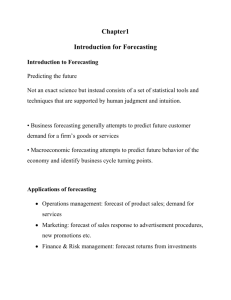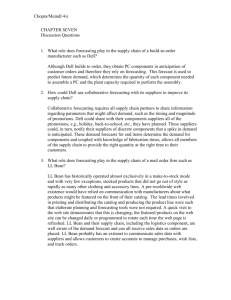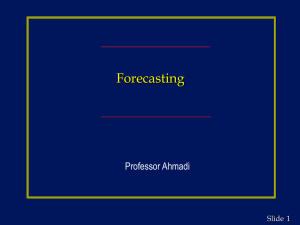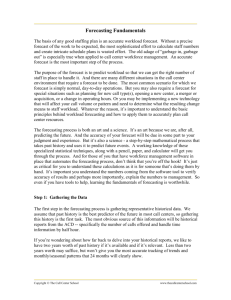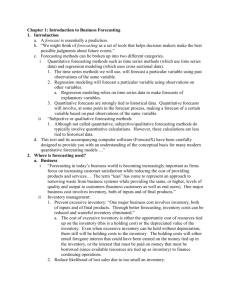Forecasting Discussion Questions & Answers
advertisement
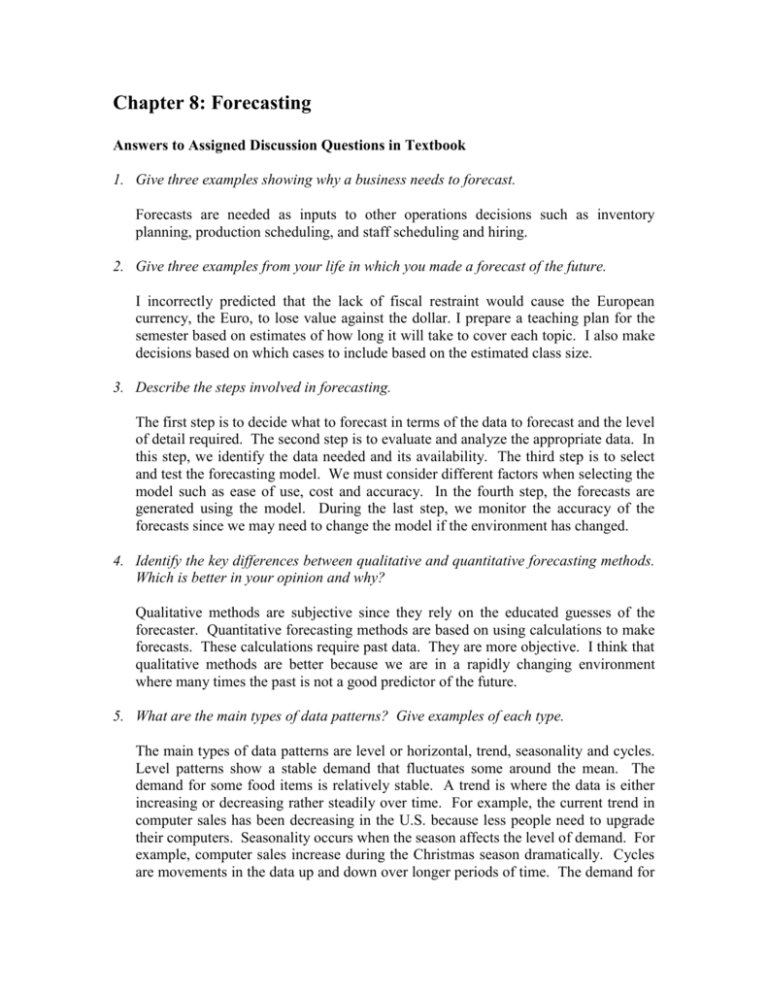
Chapter 8: Forecasting Answers to Assigned Discussion Questions in Textbook 1. Give three examples showing why a business needs to forecast. Forecasts are needed as inputs to other operations decisions such as inventory planning, production scheduling, and staff scheduling and hiring. 2. Give three examples from your life in which you made a forecast of the future. I incorrectly predicted that the lack of fiscal restraint would cause the European currency, the Euro, to lose value against the dollar. I prepare a teaching plan for the semester based on estimates of how long it will take to cover each topic. I also make decisions based on which cases to include based on the estimated class size. 3. Describe the steps involved in forecasting. The first step is to decide what to forecast in terms of the data to forecast and the level of detail required. The second step is to evaluate and analyze the appropriate data. In this step, we identify the data needed and its availability. The third step is to select and test the forecasting model. We must consider different factors when selecting the model such as ease of use, cost and accuracy. In the fourth step, the forecasts are generated using the model. During the last step, we monitor the accuracy of the forecasts since we may need to change the model if the environment has changed. 4. Identify the key differences between qualitative and quantitative forecasting methods. Which is better in your opinion and why? Qualitative methods are subjective since they rely on the educated guesses of the forecaster. Quantitative forecasting methods are based on using calculations to make forecasts. These calculations require past data. They are more objective. I think that qualitative methods are better because we are in a rapidly changing environment where many times the past is not a good predictor of the future. 5. What are the main types of data patterns? Give examples of each type. The main types of data patterns are level or horizontal, trend, seasonality and cycles. Level patterns show a stable demand that fluctuates some around the mean. The demand for some food items is relatively stable. A trend is where the data is either increasing or decreasing rather steadily over time. For example, the current trend in computer sales has been decreasing in the U.S. because less people need to upgrade their computers. Seasonality occurs when the season affects the level of demand. For example, computer sales increase during the Christmas season dramatically. Cycles are movements in the data up and down over longer periods of time. The demand for housing tends to follow a cyclical pattern based on the interest rates and other economic factors. 6. Describe the different assumptions of time series and causal models. Time series models assume that the demand is only related to its own past demand patterns. Causal models assume that the some other factor affects the variable we are trying to predict. Causal models measure the relationship between the other factor(s) and the data we are trying to forecast. 7. What are the differences among models that forecast the level, trend, and seasonality? The same set of models can be used in most cases. The key difference is that an additional feature or calculation(s) is added to the model to adjust for the effect of the trend or seasonality. 8. Explain why it is important to monitor forecast errors. It is important to monitor forecast errors because using the same forecasting model may not continue to be the best way to accurately forecast demand if changes in the environment occur. Errors in forecasts will affect our costs and customer service levels since many operations decisions are based on the forecasts. 9. Explain some of the factors to be considered in selecting a forecasting model. We should consider the amount and type of available data. For example, if we do not have any data for a new product we plan to introduce to the market, we will need to rely on quantitative methods. We should also consider the degree of accuracy, the length of forecast horizons and whether data patterns exist. We should evaluate the trade-offs between data accuracy and the cost to forecast. The forecast horizon and data patterns help determine which method is more appropriate.







